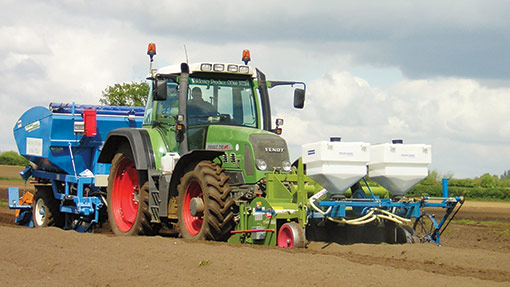Rice helps farmers control potato cyst nematode

Without knowing the details, the suggestion of using rice to help control potato cyst nematode (PCN) sounds more of an April Fool’s Day spoof than good technical advice.
But Stephen Williams, Syngenta field technical manager, is serious about the role of rice grains in tackling PCN as a means of assessing the effectiveness of incorporation technique.
“If incorporation of nematicide is too shallow, roots will be growing in an unprotected zone and are more susceptible to attack,” he warns.
“It will also allow PCN to develop into cysts at the end of the season. Incorporating too deeply would dilute the protection in a larger soil volume and compromise results.”
Speaking at the Syngenta Potato Science Live event, Mr Williams pointed out that distributing rice on the field surface and incorporating it gives a clear picture of how the company’s Nemathorin (fosthiazate) granules would be incorporated using the same equipment set-up, as well as the effect of any changes in cultivation method or soil conditions.
Using the nematicide against PCN, wireworm and spraing involves mixing 30kg of granules into 30,000t of soil, he said. Even distribution to a depth of 15–20cm will assure the optimum concentration in the root zone to protect developing plants from damage and minimise any multiplication as the season progresses.
The rice test devised by Syngenta’s application specialists has highlighted that having the applicator’s distribution fishtails too low causes banding of granules on the surface, resulting in uneven distribution in the soil profile.
It has also shown how increasing a bed tiller’s rotor speed by just 200rpm led to a 5cm increase in incorporation depth – resulting in a 20% decrease in granule concentration, whereas adjusting the depth wheel on this particular implement made very little difference to incorporation depth.
“Regular incorporation will give the best results in terms of yield increase and long-term control of PCN,” said Mr Williams. “It is also an important stewardship measure for effective nematicide use.”
Syngenta area managers can arrange an incorporation trial to help growers identify the best set-up for their machines.
Potato seed treatments
A new applicator for powder potato seed treatments will help achieve even coverage of seed tubers during planting, says Techneat Engineering.
The Powder Pro can be supplied with a bespoke mounting kit for most leading makes of both belt and cup planters and is designed primarily to deliver Monceren (pencycuron) seed treatment at the optimum location for even coverage.
An even-flow metering unit and positive action powder delivery are features of the system, which is controlled from the tractor cab, with the option to automatically match applicator output to forward speed using GPS tracking.
Operation would be further simplified where the same controller can be used to regulate a Techneat Amistar spray applicator on the planter.
Bed tiller
Growers needing a bed tiller for more than just potatoes can add bed-forming hoods to ScanStone machines for the first time.
The shaping hoods are three-point mounted in the same way as the bodies used for deep beds and are adjustable using a turnbuckle.
“Growers using our tillers to prepare deep beds for potatoes, but who also grow crops such as calabrese and broccoli, asked for the hoods,” says Graham Ferrier of ScanStone equipment manufacturer RGS Forfar. “These crops need a shallow bed, which the forming hoods produce with a nice flat top for planting.”
There are single, two-bed and triple-bed tillers in the ScanStone range, with blades secured by a rapid replacement pin-and-clip system. The spring steel locking clip is protected from wear, and both removed and pushed into place using a purpose-made tool.
The new Heavy Duty Tiller from potato equipment specialist George Moate has been developed to work reliably with tractors up to 390hp.
Principal changes are to the main gearbox, which now runs at a 1:1 ratio to reduce torque loads on the output and telescopic drive shafts, and the centre and drive bearing hubs are now machined from stronger one-piece forgings.
There are triple- and four-bed sizes, with a choice of blade shapes arranged in a patented layout designed to avoid the compacting effect of some designs while incorporating dry soil from the top and moist soil from below. This way an even mix is achieved when de-stoning.
Subsoiling legs can be fitted ahead of the rotor and a packer roller, bed-forming hoods or ridging bodies attached behind.
